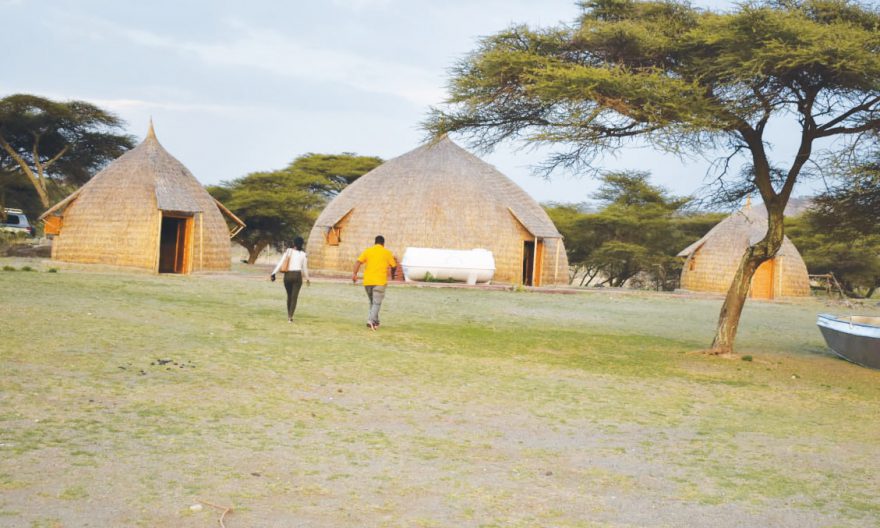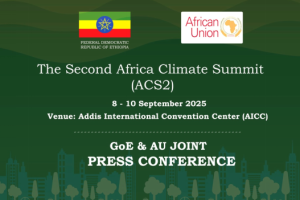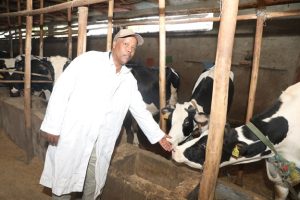
BY GIRMACHEW GASHAW
More recently, this piece writer had spent a few hours at Abijatta-Shalla National Park. The place was very exciting for tourists who want to feel uplifted by simply visiting natural scenery there. This rift valley lake has its own natural beauty. It is now serving as a tourist magnet. The various features of the lake are difficult to erase from ones memory.
The park sits in the southern part of Oromia State, around 200 kilometers south of Addis Ababa. It is known for its numerous hot springs and the abundance of steam gets to a point that sometimes the place looks like it’s covered by fog.
A craggy path leads to the shores of Lake Shalla, a geezer strewn shoreline, where hot steam vents send mists of vapor piercing through the surface and into the air.
Revered traditionally for its medical uses, the hot springs provide visitors with a well-needed rest after wandering the forests that surround it.
Mohammed Buta, 70, is one of the beneficiaries of the lake. This writer met Mohammed when he comes out of the lake. Asked why he came to the lake, he replied that “I feel ill due to the draft and I am treating myself with hot spring water.” Mohammed who had been there for three consecutive days witnessed that his health condition was good as he was washing in the hot water in the morning and night time.
Mohammed has got such medical treatment free of charge because he resides around the park.
Colder early morning visits to the lake are particularly rewarding, with the constantly spewing hot springs mixing with the cold air, sending an ethereal thick mist out onto the lake.
Across from Lake Shalla, lies Abijatta, a shallow lake surrounded in mystery. At about 14 meters deep through most of the year, the constantly fluctuating water level puzzles scientists to this day. Freshwater flows into it through the small Horakello stream, mixing with the hot water found in the lake, causing the clouds of steam that linger on its surface.
The mouth of the river is a source of relatively fresh water, frequented by water birds for drinking and bathing. The Lake is surrounded by gentle, grass-covered slopes and acacia woodlands, home to a range of endemic wildlife.
The two lakes take up over half of the 887 square kilometers of the park.
Towering over lakes stands the highest peak in the park, Fike. Tracks to and around the park are constantly being developed, however at present four interchanging, winding paths bring visitors through the evergreen trees and into the heart of the national park.
Approaching from the capital you first reach the Horakello entrance, where the small Horakello stream flows between lakes Langano and Abijatta
Great White Pelicans, Storks, neon pink Flamingos, Egrets and Herons are often found in the park. You will also see Ostrich in the forests en route to the lakes.
Swinging in the trees a range of endemic monkeys can be found, such as the friendly Colobus monkey, although these are seldom spotted. Most of the wildlife at Abijatta-Shalla is of the bird variety!
Most people visit Abijatta-Shalla while passing through the Rift Valley, either en route to the Bale Mountains, the Omo Valley, or heading back up to Addis Ababa. The local community has been contributing their share through protecting their culture, protecting nature and by involving in many tourism related activities. Contribution of Local Community for Ecotourism Development in and around Abijata-Shalla Lakes National Park.
Gita Eirbo is the park’s scout leader; there was conflict with the community residing around the park. He recalled that the conflict flares up due to the ever increasing population and the rise of unemployed youths.
As a result, the youth have been clearing the surrounding forest. As the area of desert, they have no other options than cutting the trees so as to generate income. Through time, the youth are changing their mind set attending the awareness raising training that was given to them. Now, the youth are getting benefit from the park organizing themselves in different associations.
“Sustainable Environment Development Action (SEDA) offers training for the youth and organizes them in different associations. Now, the youth are cooperative with us so as to protect the park and its environs” Gita said.
Previously, the park and the community had no common ground. The approach between them is as cats and mouse, more likely to ignore or avoid each other than engage. Later on, it is possible to create common ground when the people are getting benefit out of the park following the intervention of SEDA. However, there is no road that connects the park with the main road.
Kellil Weyesso, is a member of OA Abajiba Entertainment Association established by the youth residing in the area. Together with other youths, he has a vision of getting benefit from the park. Indicating that he has got training in hotel and reception, Kellil hopes to get income when the scenery of the park attracts the eye of visitors. Unknowingly, he was the one who cut trees so as to gain something out of it. Now at this time, let alone cutting trees, he thinks about how the park developed and increased tourist flow and their stay.
Now Kellil works day and night to compensate for what he did even if he has not gotten a penny from the associations he belongs to. Through developing ourselves, we will contribute some for our countries to be altered. The association which has 228 members does not think for gain they have received for the time being.
Abdul Safo, 25, is another member of the association organized to benefit from the park. He together with other youths gained boat safety courses so as to assist the tourists who are not able to boating.
Accessible via the Ziway–Shashamane highway, the national park does not have accommodation on site. Camping is allowed in certain areas on site for the more adventurous travelers.
The multifaceted stride of the community to upgrade the park is worth appreciation. In order to make their vision a reality, all stakeholders should support them. If potential investors engage in the area, the infrastructure would further be developed, the place would be a tourist destination for a number of visitors apart from protecting the environment that contributes some for the world that has been affected by climate change.
THE ETHIOPIAN HERALD TUESDAY 12 JULY 2022




